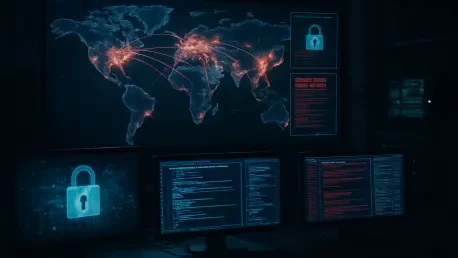As the digital world becomes increasingly interconnected, the advancements come with heightened risks of cyber threats, demanding robust cybersecurity strategies. Cybersecurity has become more crucial than ever, influencing not only the safety of sensitive data but also the stability of the global economy. The rise in cybercrime, predicted to cause trillions in economic damage, accentuates the urgency for effective defensive measures. Coupling this threat with technological progress, where artificial intelligence and quantum computing play significant roles, both individuals and corporations must adapt to safeguard their digital realms. The current narrative dives deep into the cybersecurity evolution, offering a comprehensive take on defending against the sophisticated tactics employed by cybercriminals today.
Evolution of Cyber Threats
Historical Context and Modern-day Challenges
The progression from rudimentary viruses to advanced AI-driven cyber threats highlights a vivid transformation in the cybersecurity landscape. In earlier times, threats were often isolated, primarily focusing on individual systems or small networks. However, today’s threats operate on a larger scale, leveraging the connectivity of the internet to spread rapidly and cause more significant damage. Cybercriminals increasingly use automation and machine learning to create dynamic threats that adapt, learn, and evolve, making them harder to detect with traditional cybersecurity measures.
Moreover, the proliferation of easily accessible hacking tools and kits on the dark web has democratized cybercrime, allowing individuals with minimal technical expertise to launch sophisticated attacks. As these tools become more advanced, the lines between nation-state actors and independent hackers blur, escalating the potential impact of cyber incidents. The modern cybercriminal utilizes social engineering, exploiting human psychology alongside technical vulnerabilities, creating a multi-faceted threat landscape that challenges existing security paradigms.
Emergence of AI and Quantum Computing
The advent of artificial intelligence and quantum computing is reshaping cybersecurity practices, offering both challenges and opportunities. Malicious actors employ AI to automate attacks, craft convincing phishing scams, and perform deepfakes, rendering traditional defenses less effective. This paradigm shift urges cybersecurity professionals to rethink their strategies, focusing on integrating AI to predict threats, automate responses, and bolster defense mechanisms.
Simultaneously, quantum computing threatens current encryption methodologies by potentially cracking codes that protect sensitive information. This transformation requires immediate attention to develop and implement post-quantum cryptography methods to maintain data confidentiality. While these technologies can undermine existing security frameworks, when used ethically, they offer unparalleled advantages for cybersecurity professionals. AI can introduce predictive threat modeling and real-time anomaly detection, crucial for anticipating the intent and patterns of malicious entities. Quantum-resistant encryption techniques are emerging as a vital line of defense, showcasing the dual role of technological advancements in both expediting and resolving cybersecurity challenges.
Building Fundamentals for Cyber Defense
Importance of Patching and Updates
Regular software patching and updates sit at the core of any effective cybersecurity framework, ensuring vulnerabilities in software applications and operating systems do not become gateways for cyber threats. As each patch represents a resolved vulnerability, delaying updates increases the risk of exploitation by threat actors who quickly capitalize on known flaws. Despite being a straightforward measure, many organizations overlook timely patching, culminating in significant breaches that cost heavily.
Organizations employing comprehensive patch management strategies can fortify their defenses, ensuring all systems, applications, and hardware receive necessary updates promptly. Automated update protocols reduce the risk of human error and resource constraints, providing seamless protection. Regular audits and vulnerability assessments complement patch management, allowing organizations to pinpoint and mitigate weak spots, further solidifying their cybersecurity perimeter.
Multifactor Authentication and Enhanced Password Policies
Strengthening authentication methods through multifactor authentication (MFA) and robust password policies is crucial in preventing unauthorized access. MFA requires users to provide two or more verification factors, greatly reducing the risk of breaches even if passwords are compromised. This layered security approach becomes indispensable in environments where sensitive data is regularly accessed and stored.
Reinforcing a strong password policy acts as the first line of defense against unauthorized access attempts. Educating users about creating complex, difficult-to-breach passwords emphasizes the gravity of cybersecurity hygiene. Organizations leverage password management systems to ensure compliance without overwhelming users with complex credential management. MFA builds upon robust passwords, offering an additional verification layer through biometric data or mobile devices, adding complexity to the cybercriminals’ infiltration tactics.
Zero Trust and Advanced Encryption
Adopting a Zero Trust Model
In a climate of continuous cybersecurity evolution, the adoption of Zero Trust architecture marks a paradigm shift from traditional perimeter-based security models. Zero Trust operates under the principle that threats could arise internally or externally, with no trusted zones within a network. This approach ensures verification at every access point, micro-segmenting networks to evaluate each access request based on identity, device, and location.
Implementing Zero Trust principles necessitates a thorough understanding of network infrastructure, emphasizing least-privileged access and continuous verification. Each request for data access is treated as if it’s coming from an open, unsafe network, thereby increasing security measures across the board. It revolutionizes the access management domain, making it substantially harder for unauthorized users to move laterally and gain unrestricted access to sensitive data once inside.
Utilization of Advanced Encryption Methods
Advanced encryption techniques, particularly those resilient to quantum computing advancements, are essential in safeguarding data confidentiality amidst evolving cyber threats. Standard encryption algorithms, such as RSA and ECC, face potential obsolescence with the rise of quantum computers capable of solving complex mathematical problems exponentially faster than classical counterparts.
Integrating post-quantum cryptographic algorithms into existing networks mitigates the risks posed by this nascent technology. Encryption aids in maintaining data integrity and confidentiality, even if intercepted during transfer. The transition towards advanced encryption techniques not only responds to imminent computational threats but also reassures stakeholders of data protection commitments, reinforcing trust in organizational systems.
Real-world Applications and Adaptations
Sector-specific Implementation Successes
Real-world examples provide valuable insights into successful cybersecurity implementation across various sectors. In healthcare, for instance, overseeing sensitive patient data requires stringent adherence to privacy regulations and robust security frameworks. Hospitals have employed AI-driven monitoring systems that detect anomalies within the network, protecting patient data from unauthorized access attempts and ransomware attacks.
Financial institutions face a constant threat landscape, driven by high rewards for malicious entities targeting financial data. By adopting multifactor authentication, AI threat intelligence, and blockchain technologies, these institutions build fortified walls against unauthorized access and transaction frauds. Lessons from these sectors highlight the importance of industry-specific strategies, embracing innovation while focusing on core cybersecurity principles tailored to individual sectoral challenges.
The Role of Continuous Education and Vigilance
Formalizing continuous education programs emphasizes an individual and organizational commitment to evolving cybersecurity standards. Digital literacy and regular training programs bring heightened awareness to potential threats and evolving tactics employed by cybercriminals. The role of employees as the first line of defense underscores the importance of educating them to recognize phishing scams, suspicious activities, and ensuring responsible use of organizational resources.
Vigilance reinforces cybersecurity measures, aligning defensive strategies with the latest threat intelligence. Establishing a proactive cybersecurity culture encourages staff to remain informed about emerging risks and best practices. Regular simulations and penetration testing assess organizational readiness against advanced threats. Ensuring all stakeholders understand cybersecurity as a continual, dynamic process bolsters efforts to neutralize threats before they escalate into significant breaches.
Reflecting on Cybersecurity’s Future
Emphasizing Economic Benefits of Cybersecurity Investment
Quantifying the economic benefits of investing in robust cybersecurity measures forms a persuasive argument for organizational stakeholders. Reduced incident recovery costs, prevention of business disruptions, and enhanced operational resilience underscore the financial argument for significant cybersecurity investment. The downstream effects of a secured digital environment, such as increased customer trust and regulatory compliance, translate into tangible economic advantages.
Organizations must evaluate cybersecurity spending as a dynamic, evolving need rather than a static budget item. By investing in modern technologies, cybersecurity brings correlated cost savings through the prevention of breaches and protection against potential reputational damages. The calculation of return on security investment (ROSI) considers factors like potential losses averted, creating a business case that appeals to both technical and fiscal management teams within organizations striving for long-term digital protection.
The Path Ahead for Cybersecurity Practices
The cybersecurity landscape, characterized by relentless innovations and threats, necessitates adaptability and continuous learning. Organizations that proactively evolve cybersecurity defenses prepare themselves to meet new challenges, leveraging cross-disciplinary expertise and cutting-edge technology. Cybersecurity strategies must remain pliable, accommodating changes in technology, threat vectors, and regulatory frameworks.
The shift to proactive, rather than reactive, responses achieves better security outcomes, preparing organizations to face unforeseen risks confidently. In practicing vigilance and adaptation, companies can shield themselves from destructive R&D cycles. Ultimately, cybersecurity’s path is dynamic, with professionals poised to leverage innovation, anticipate challenges, and steer organizations toward fortified digital futures.
In contemplating future strategies amidst an unprecedented cyber threat environment, the article outlined essential strategies, emphasizing evolved defenses and robust data protection. By fostering inclusive approaches, investing in security infrastructure, and perpetuating vigilance, both individuals and organizations engaged with emergent technologies can confidently secure their digital ecosystems against complex threats defining this era.









